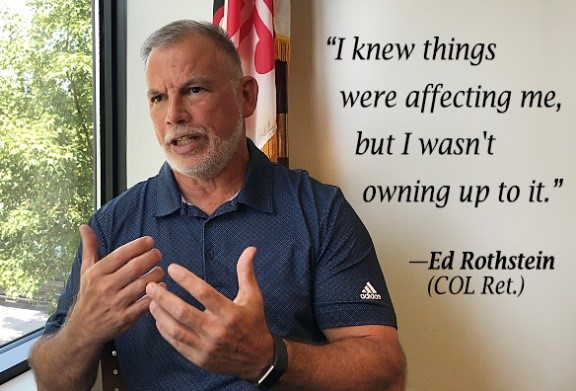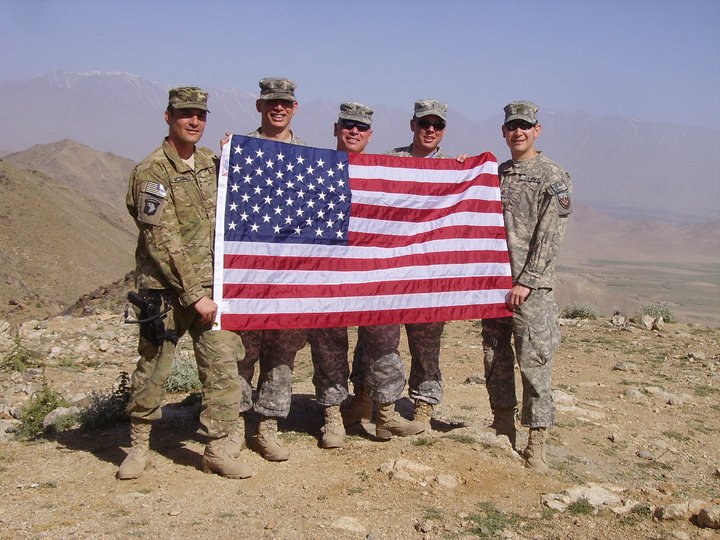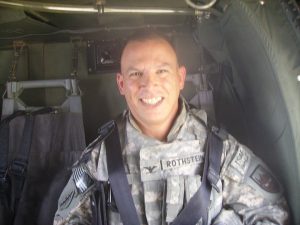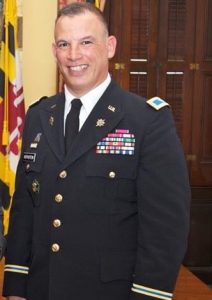Silencing the Stigma
This is an article from the Winter 2020/21 issue of Combat Stress
By COL (RET) Ed Rothstein
Silencing the stigma remains a relentless problem for those who have worn the uniform. The influx of urgent information and the reality of disturbing situations create stressors that our Service Members know all too well and it’s unending. While Department of Defense employees and civilian contractors are not immune to absorbing the complex weight of keeping our nation safe. As the former Fort Meade Garrison Commander, I knew that my decades in uniform took some kind of toll on me. I also hesitated to reach out. Like so many other Service Members and civilians, I was confronted with the stigma of asking for help. With my experiences as a Soldier assigned to Fort Meade and NSA, as well as deployments to Iraq and Afghanistan, I was no stranger to the many sides of this stigma. It wasn’t until my 2011 assignment as the Fort Meade Garrison Commander, however, that I unexpectedly found myself referring some of my Service Members to resources for drug and alcohol treatment, stress management, treatment of depression, instruction in healthy living, and family counseling.

For a while, some of the situations didn’t make sense to me and until I delved deeper into why some Service Members acted the way they did. I had an “ah-ha” moment, realizing that most Service Members don’t have the opportunity to decompress. This accumulates over time. This was the beginning of our discussions about building the anticipated Education and Resiliency Center. The Education and Resiliency Center, currently under construction at Fort Meade’s Kuhn Hall, will serve as a community hub, providing vital resources, services, and programs for Service Members, their families, and the Department of Defense (DoD) community across the Fort Meade Region. This collective scope is also known as Team Meade. The Center remained a capstone project for me during my Command at Fort Meade from 2011 to 2013, as I continued to do my utmost to support the needs of Team Meade.
There are two types of intensities our Service Members and the DoD community experience that warrant a human need to decompress: the visible Soldier physically deployed into harm’s way and those serving in agencies and organizations who conduct discreet operations for national security. While the contexts are wildly different, each are on the frontline and carries a unique tension few understand. They are different battlefields, but the need to decompress is critical in both scenarios. In many ways, I identify with both.
Shortly after my retirement from Fort Meade in 2014 and during a routine medical exam, a Veterans Administration physician recognized the impact that 30 years as a Service Member had on me psychologically. I never processed my experiences from the many times that I was in harm’s way. Add to that the stressors associated with continuous stateside and other sensitive operations, it all just built up. Honestly, it was just time to talk about it and to let it go.

In 2010 with a handful of colleagues on the outskirts of Kabul taking the opportunity to highlight the USA and teamwork.
Without support, Service Members often shut down internally. Family members see it first, yet they also don’t know what to say or do in response, especially should the situation escalate. Oftentimes, I isolated myself without others realizing it. My wife of 27 years and kids were impacted the most. I wasn’t always readily available for them because I was shut down and I wasn’t aware of how I was affecting the people around me. I couldn’t engage with the people I love the most.

Today, I do obtain mental health intervention. I take time to process my experiences with people who understand, with people whose business it is to help me work through and walk through my trauma. I feel a whole lot healthier today in every aspect of my life, my relationships, and my community. Have I crossed the finish line? No, as this will take a lot more time, but I have turned a corner from a pretty dark place.
I have a unique perspective — Soldier, leader, the recipient — on the importance of resiliency programs. This fuels my ongoing passion to see the Education and Resiliency Center become a reality. As a current FMA Foundation board member, I am also committed to bring awareness to the fact that resiliency programs reach far beyond the installation, as the 57,000 plus employees who work there are also members of surrounding communities. We all need to be aware of what our Service Members go through and to help pick folks up by the bootstraps and be sure they are ready and healthy to take care of their families and serve our Nation. A majority of the Fort Meade workforce lives outside the fence line, and we want them and their families to be healthy and ready to do the job they are being asked to do.

Left to right, Baltimore Orioles pitcher Jason Johnson, Luis Rosa, Col. Edward C. Rothstein, and the Orioles mascot stand together before a game at Oriole Park at Camden Yards. In 2012 throwing out the first pitch for the Orioles baseball game on Memorial Day Weekend. Met the wounded warrior that morning and brought him on the field with me giving him the ball to throw to me and then I finished the throw. “One Team, One Fight” Sunday, May 27, 2012, in Baltimore. (Photo by Steve Ruark)
Resiliency resources are currently available for Service Members and no one has to wait until retirement to use them. Unfortunately, these important resources are also limited and spread both outside and inside the installation. Fragmented lives cannot be supported well with fragmented resources. In fact, scattered geography of resources often makes it easier to hide amidst the hustle and bustle, thereby fostering the unwanted stigma. As we continue to move toward having resiliency resources and programs under one roof, not only will the opportunity to expand existing programs arise, but the Education and Resiliency Center itself will become a symbol of silencing the stigma.
Click here to watch Silencing the Stigma on Vimeo.
ABOUT THE AUTHOR
COL (RET) Ed Rothstein – While attending Lock Haven University of Pennsylvania, Ed enlisted in 1983 and was assigned to 1/314th Mechanized Infantry (USAR) while also completing ROTC. He was then commissioned in 1985 and upon graduation in 1986 began his active duty career as a Chemical Officer assigned to 6-3 ADA (Patriot) in Kaiserslautern Germany for the next four years. In 1990 Ed transitioned to the Military Intelligence Corps where he spent the rest of his career through retirement in 2014. During that time, he had multiple assignments in staff and command positions from tactical, operational, and
strategic with duty stations that included Fort Ord, California; Fort Meade, Maryland; Heidelberg, Wiesbaden, and Stuttgart Germany; Fort Carson, Colorado. Some of these assignments included Company Command 743rd MI BN, Battalion S2, 4-17 IN and S3, 743rd MI BN, Division G2, 7ID, Army Staff (DCSINT Staff), multiple tours at the National Security Agency and prior to retirement, Garrison Commander at Fort Meade Maryland. In addition, Ed has served multiple tours in combat supporting OIF and OEF operations from tactical to strategic. Ed attended both resident Command and General Staff College at Fort Leavenworth along with the Senior Staff College (ICAF) at the National Defense University. Currently, Ed serves in an elected position as the
President of the Board of Commissioners for Carroll County Maryland while also giving back to the community through serving on multiple non-profit boards and running ERA Advisory LLC. Ed is blessed with his wife ongoing 27 strong years and two amazing kids, Emily and Sam.
Combat Stress Magazine
Combat Stress magazine is written with our military Service Members, Veterans, first responders, and their families in mind. We want all of our members and guests to find contentment in their lives by learning about stress management and finding what works best for each of them. Stress is unavoidable and comes in many shapes and sizes. It can even be considered a part of who we are. Being in a state of peaceful happiness may seem like a lofty goal but harnessing your stress in a positive way makes it obtainable. Serving in the military or being a police officer, firefighter or paramedic brings unique challenges and some extraordinarily bad days. The American Institute of Stress is dedicated to helping you, our Heroes and their families, cope with and heal your mind and body from the stress associated with your careers and sacrifices.

Leave A Comment
You must be logged in to post a comment.